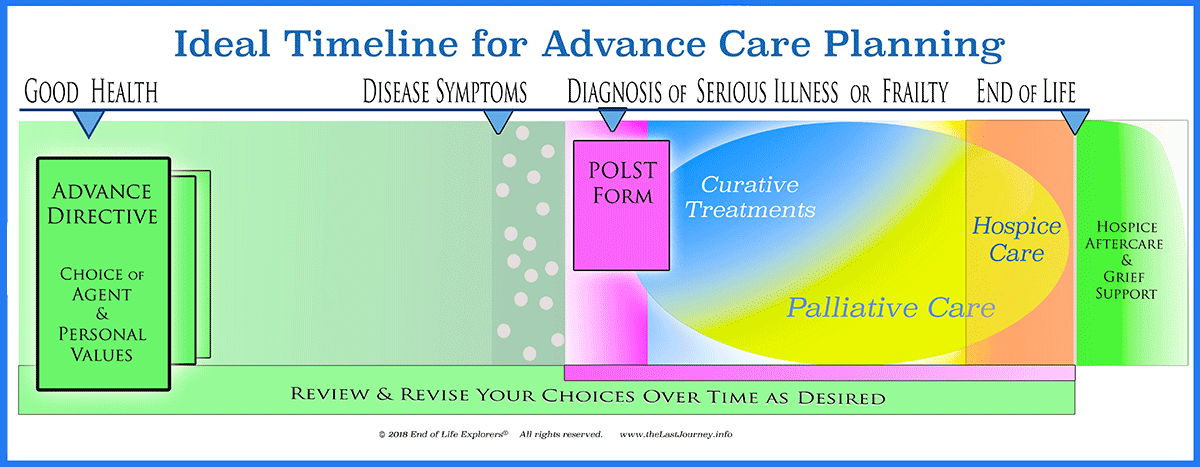
ADVANCE CARE PLANNING: Begin Exploring | Choices / What Matters | New Paths | Choose Agent
Create Directive | Share | Store-Revise | Peace & Grace
Define Your Wishes in an Advance Directive
 As a general term a “directive” refers to any document that you prepare, sign, date and witness – in advance – to describe your wishes for care at a future moment when you may have a serious medical condition, a life-threatening illness or medical emergency and cannot speak for yourself.
As a general term a “directive” refers to any document that you prepare, sign, date and witness – in advance – to describe your wishes for care at a future moment when you may have a serious medical condition, a life-threatening illness or medical emergency and cannot speak for yourself.
An Advance Directive is a specific form that is evolving to be the centerpiece of all end of life care planning documents.
An Advance Directive is the document where you can:
State your values and preferences for the way you want to be cared for at the end of your life.
State where you would like to receive care (home, hospital, skilled nursing etc.).
Name your Agent who will speak for you when you cannot speak for yourself.
Define which medical treatments you do or do not want at the end of your life.
State your choices on organ donation and burial options.
Advance Care Planning is a Process
You have already embarked on the process if you have defined what matters to you at the end of your life. An Advance Directive is the document that will define your wishes for your care providers and loved ones as well as your Agent. Start the process by understanding some facts and learning what to do next.
Confusing Terms
Advance Health Care Directive or Advance Directive for Health Care or simply Advance Directive – as it is referred to on this site – all refer to the same type of document. In some states an Advance Directive is called a Declaration. Whatever the name. the intent of the documents are the same – to identify your particular wishes for end of life care.
Working with Advance Care Planning Forms
It is important to make some choices now, while you are healthy. Yet, it is good to know that you may change any of your choices as your health changes or when you simply decide to make different choices.
It seems confusing, if not overwhelming, at first. Which forms do you need now? Which forms are for time when you are seriously ill? How will they be used and considered? Who gets copies? Start with a basic orientation to what is important:
Do I Need a Lawyer?
A lawyer is NOT required to create a legally valid Advance Directive in any state in the US. If you feel you must use a lawyer, be sure to choose an Estate Planning or Elder Law attorney who is familiar with Advance Care Planning issues.
If I have an Advance Directive will it be legally honored and enforceable?
If you create, sign, date and properly witness an Advance Directive it becomes a “legally recognized document” – that means it is a clear and definitive documentation of your personal preferences for end of life care. While it is not legally binding, meaning that it is a direct order that MUST be followed exactly, it IS a strong statement of your desires to have or not to have certain medical procedures that should be given genuine respect.
Myths & Facts About Health Care Advance Directives
American Bar Association Commission on Law and Aging has created a straight forward and useful document identifying ten myths and providing factual clarifications about Advance Directives. This document will help both you and your Agent know essential facts.
Free PDF Download
Frequently Asked Questions about Advance Directives
Written by the Vermont Ethics Network, this document provides answers to a baker’s dozen of common question about Advance Directives.
Learn More
Consistency of Information Among Forms
Several different types of forms dealing with end of life issues have evolved over time. The trend in medical care is to combine several of the forms into an Advance Directive. and then, if necessary, add additional preferences and information in a physically attached Addendum to the Advance Directive. Combining information makes critical information available in one place – especially important in an emergency situation. It also makes it easier to maintain consistent information so that one form does not state something that conflicts with another form creating confusion instead of clarity.
What if There is a Conflict of Choices on Different Forms?
Generally, if the choice stated about a particular treatment on one form is different on another form, the most recently dated form will be viewed as the most valid representation of your end of life choices.
Scroll down to see the Forms for Advance Care Planning illustration below to help understand which forms combine information such as choice of Agent and personal preferences and which are separate, stand alone forms created for a specific purpose.
Is an Advance Directive Legally Binding?
An Advance Directive and any added addemdum are not legally binding – in other words, they are not medical orders that must be followed. Medical orders must be written by licensed physicians or physician assistants or nursing assistants. A POLST Form is a legally binding medical order. It is a separate document that you discuss with your physician and sign at a time when you become seriously ill. For more information see POLST form under Serious Illness Section of this site.
Advance Directives are strong statements of your personal choices and preferences for the care you want to receive, order not want to receive, at the end of your life.
Your Advance Directives should be given genuine respect by your Agent, and any health professional or care provider involved in your care. By thoughtfully creating these documents now, you are giving yourself a gift. Without your direction, few people if any, will know what care you do and do not want. Your Advance Directive is your best chance for having the kind of dying experience that would be meaningful to you. The current US medical system is programmed to perform every treatment possible to prolong life at all costs, even if the treatments may prolong natural dying and cause suffering especially for elders.
Forms – Forms – Forms !
 Living Will
Living Will
In general, a Living Will is a stand alone document. It is commonly drafted by an attorney as a section of a Will, personal Living Trust or Family Trust. In most instances it provides general statements (not specific preferences for care) regarding life-sustaining treatments at a time when a person lacks the capacity to make medical decisions. Historically, a Living Will is stored in safe deposit box that is not easily reached in an emergency.
In some states it is possible to have both a Living Will and an Advance Directive.
If so, check that the specific medical and personal choices and preferences are stated in an Advance Directive do not conflict with the general statements in a Living Will.
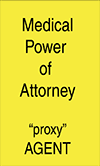 Medical Power of Attorney
Medical Power of Attorney
This is the written designation of your health care Agent described in Step 3. This is the person who will speak for you, advocate for you, and make critical medical decisions for you if you can not make them for yourself. Historically this has been a separate document and can still be created as a separate document. However, the trend in medicine is to incorporate this naming it into your Advance Directive. Doing this helps define the essential information into one place.
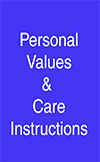 Personal Values and Care Instructions Statements
Personal Values and Care Instructions Statements
This is a statement of the values and preferences for care at the end of life that you identified in the conversations with friends and loved ones. You may also write specific instructions for medical treatments that you do or do not want toward the end of your life.
In the past this has been a separate form from an Advance Directive, but it is becoming more common to incorporate this information into the directive to simplify keeping information in one place. It is ideal for your personal values it to be incorporated into you Advance Directive. If you decide to keep it as a separate form, be sure to physically attach it as an Addendum to your directive. See Adding Information to an Advance Directive below.
“Forms for Advance Care Planning” below provides an overview of various types of “directives” and how some can combine into the primary form that is the centerpiece for end of life care planning: your Advance Directive.
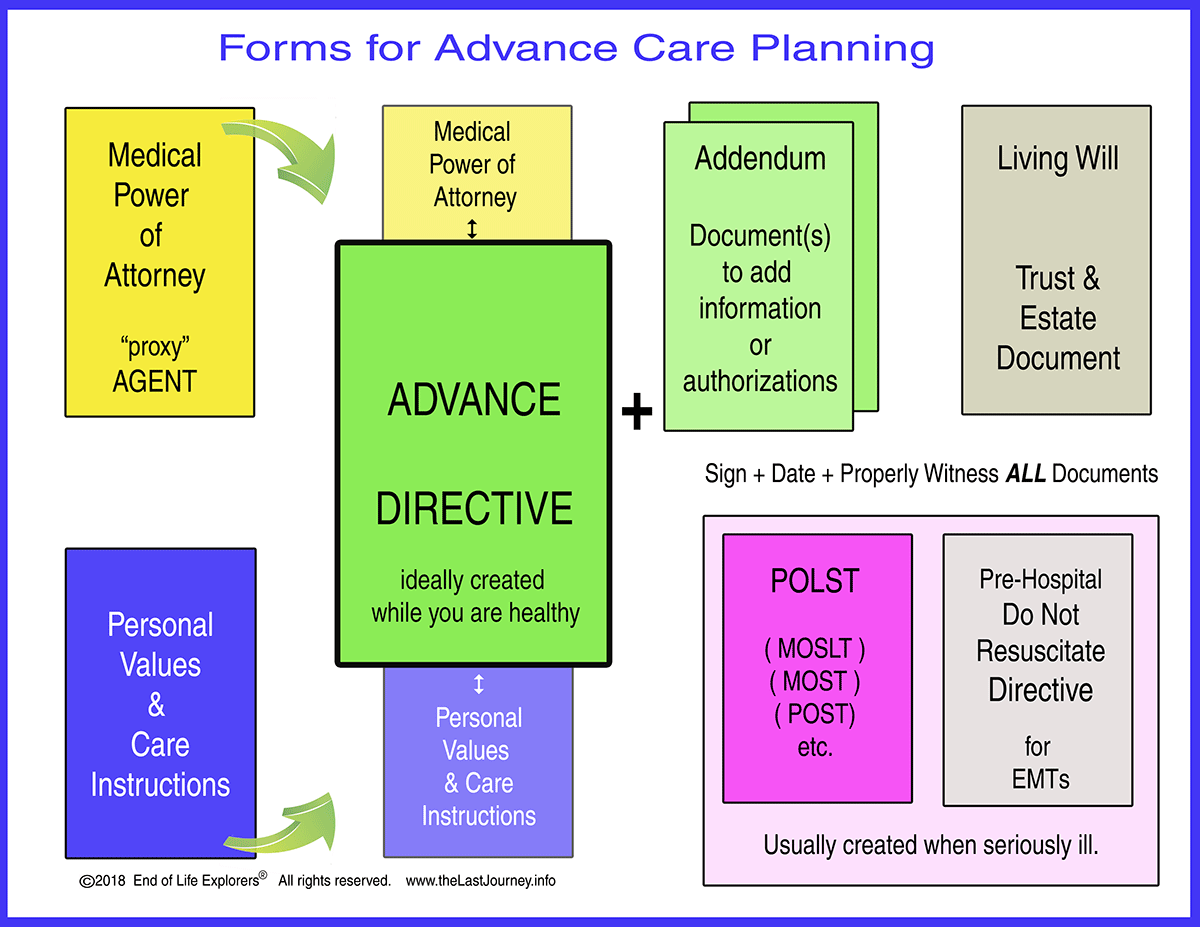
POLST Form and Pre-Hospital DNR Directive
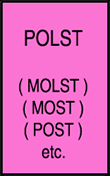 POLST stands for Physician Orders For Life-Sustaining Treatment – This form may go by the names of MOLST , MOST, POST etc. in different states in the US. The purposes of the form, no matter what it is named, is to let emergency personnel know whether or not you authorize receiving the full measure of high-intensity, life- saving measures, or some measure of treatments and/or comfort focused care. It is a form that you discuss with your physician when you have a diagnosis of a serious disease or become critically ill.
POLST stands for Physician Orders For Life-Sustaining Treatment – This form may go by the names of MOLST , MOST, POST etc. in different states in the US. The purposes of the form, no matter what it is named, is to let emergency personnel know whether or not you authorize receiving the full measure of high-intensity, life- saving measures, or some measure of treatments and/or comfort focused care. It is a form that you discuss with your physician when you have a diagnosis of a serious disease or become critically ill.
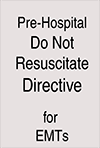 The POLST form and Pre-hospital DNR Directive are stand-alone forms. Neither form is part of an Advance Directive. Since they are designed to be used primarily when a person is seriously Ill, they are described in detail in the Serious Illness section of this site.
The POLST form and Pre-hospital DNR Directive are stand-alone forms. Neither form is part of an Advance Directive. Since they are designed to be used primarily when a person is seriously Ill, they are described in detail in the Serious Illness section of this site.
For more information see the POLST Form under Serious Illness – POLST section of this site.
When to create an Advance Directive and when to create a POLST form:
Choosing the Advance Directive that is right for you
Creating your personal Advance Directive is such a vital process that many caring organizations and health care systems have created an Advance Directive form to make it easy for you to complete this essential step.
There are three types of forms – All are legally recognized forms. Look then over and choose the form that suits you.
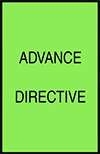 Basic – Advance Directive forms that have some, but not large amounts of space for you to indicate your preferences for care.
Basic – Advance Directive forms that have some, but not large amounts of space for you to indicate your preferences for care.
Expanded Advance Directive forms that provide more explanation of choices and more space for you to state your choices to have or not have certain medical treatments.
Focused Advance Directive forms which address the specific needs of individuals with Dementia, Alzheimer’s disease, and mental challenges etc.
Note: Basic, and even Expanded directive forms do not generally address your preferences for care if you should develop dementia or other cognitive disease such as Alzheimer’s. The Dementia Directive in the Focused directives section below provides a thoughtful outline of choices you might make over the progression of these conditions should they occur in the future. You might want to consider the Dementia Directive as an added document – an Addendum to your main directive. There are directions below on how to add effectively information to your Advance Directive.
BASIC Advance Directive Forms
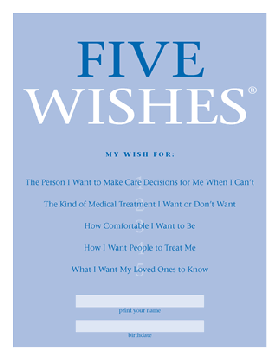 Five Wishes
Five Wishes
The organization Aging With Dignity offers an easy to understand format for an Advance Directive that asks you to consider and answer five basic questions relating to your medical choices, emotional, personal and spiritual wishes for your end of life care. Available in state specific forms and multiple languages $5.00 per form. The site also offers the ability to fill out the Advance Directive form online. $5.00 fee
Learn More
State Specific – Basic Advance Directive Forms with explanations and guidelines.
CaringInfo
National Hospice and Palliative Care Organization
Go to this site to download your state’s basic forms with step by step explanations of each part of the form. FREE
Learn More
Prepare for Your Care
State specific Advance Directive forms with guidelines
Created by the Regents of the University of California, the site provides basic concepts of end of life care and adds easy to follow instructions in easy to understand style. Easy-to-understand videos cover several common questions about Advance Directives. Download information and forms free.
Learn More
EXPANDED Advance Directive Forms
You can choose to use any one of these excellent Advance Care Planning forms to walk you through the end of life choices. Each has been developed separately by caring professionals who know how important it is that you make choices for your end of life care when you are healthy. Sing, date and witness them properly and take a copy to discuss your choices with your primary care physician. If you develop a serious illness it is a good time to review and revise your directive as appropriate. You are always free to change your mind about your choices. See sections below for step by step guide for changing your choices if needed.
Each of the following Advance Directives includes the following elements in easy-to-use forms:
- Your values for a meaningful quality of life
- Naming your health care Agent
- Explanation and choices on life-sustaining measures Choice for organ donation
- Mortuary and burial designation
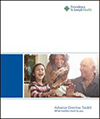 Advance Directive Tool Kit Guide and Advance Directive Form
Advance Directive Tool Kit Guide and Advance Directive Form
You will find a thoughtfully prepared and excellent Advance Directive guide and form created by the Institute for Human Caring at Providence St. Joseph Health. It steps you through understanding the high-intensity, end of life treatments, and provides space for you to make your own choices. Several state specific adaptations of this helpful guide and form are available here. Download from their web site. FREE
Learn More
 Sharp Healthcare Advance Health Care Directive Form
Sharp Healthcare Advance Health Care Directive Form
A very easy to follow yet comprehensive form thoughtfully developed by Sharp Healthcare in San Diego, California. It is available in both English and Spanish – Learn More
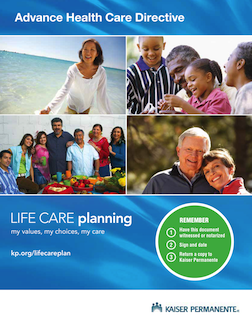 Kaiser Permanente Advance Health Care Directive
Kaiser Permanente Advance Health Care Directive
Another excellent form that helps you understand the choices you might make for your end of life care. developed by Kaiser Permanente Healthcare. On this site you can select the Kaiser form that is used in your area.
Available in English, Spanish and Chinese .- Learn More
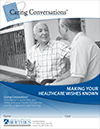 Caring Conversations
Caring Conversations
The Center for Practical Bioethics has created an excellent, easy to understand guide covering your essential preferences and all other required elements. It includes a clear description and graphics of the paths, “trajectories” of different types of illness or serious health condition to help you and your agent think about your choices. They also provide a free download titled: Caring Conversation for Young Adults. Click on the link below to download the free Caring Conversations Workbook and forms from their website.
Learn More
FOCUSED Advance Directive Forms
Important choices you can make now to guide your healthcare team and loved ones if you develop:
Dementia
Dementia Directive – an important addition to your Advance Directive.
Very helpful Advance Directive created by Dr. Barak Gastner who is featured in the article below. In easy to understand language it outlines stages of mild, moderate and severe dementia and asks user to choose what type of care he or she would like or not like to have.at the various stages understanding and making care choices at each stage of dementia. It is easy to use and would make an excellent Addendum* to any Advance Directive. If used alone, you would need a separate document to designate a person to be your Power of Attorney for Healthcare. Click the link below to download from their web site. FREE
Learn More
Alzheimer’s Disease
One Day Your Mind May Fade. At Least You’ll Have a Plan
by Paula Span – article in the New York Times
Learn More
A Guide and Directive for Families and People with Alzheimer’s
The Conversation Project has a guide for families and an Advance Health Care Directive for people with Alzheimer’s or Dementia. Click on the link below to download from their web site. FREE
Learn More
Psychiatric, intellectual or mental disabilities.
National Resource Center on Psychiatric Advance Directives
A psychiatric advance directive (PAD) is a legal document that documents a person’s preferences for future mental health treatment, and allows appointment of a health proxy to interpret those preferences during a crisis. View their state by state information along with many pertinent resources.
Learn More
Thinking Ahead Matters
Thinking Ahead, My Way, My Choice, My Life at the End
Excellent resources have been developed by the Coalition for Compassionate Care in California including Thinking Ahead Matters, a comprehensive manual on being a conservator and other issues surrounding end of life care for people with intellectual and mental disabilities. You will also find an Advance Health Care Directive for people with these disabilities. Download the documents from their website.
Learn More
Addendum – Adding Information to an Advance Directive
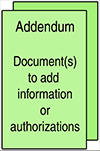 Adding more information or authorization to your Advance Directive is termed adding an “Addendum”. In legal terms an Addendum is a document that you add to an existing document in order to add information or to add specific authorizations. This can be very useful if a topic is not adequately addressed in your directive (such as: your preferences for care if you should develop dementia or Alzheimer’s). Care must be taken that the preferences for you end of life care stated in your Advance Directive match any similar statements in an Addendum.
Adding more information or authorization to your Advance Directive is termed adding an “Addendum”. In legal terms an Addendum is a document that you add to an existing document in order to add information or to add specific authorizations. This can be very useful if a topic is not adequately addressed in your directive (such as: your preferences for care if you should develop dementia or Alzheimer’s). Care must be taken that the preferences for you end of life care stated in your Advance Directive match any similar statements in an Addendum.
If you make changes to either document in the future, it is best to recheck that the provisions in each document match and then have both the Advance Directive and the addendum re-signed, dated and properly witnessed on the same day.
If you create an addendum after signing and witnessing your Advance Directive, you must have your Advance Directive resigned, dated and properly witnessed again – at the same time you sign, date and properly witness the addendum. This is true even if you do not change anything in the Advance Directive.
Always physically attach any addendum to you Advance Directive and be sure your Agent, family, your physician and other care providers receive the complete updated copies as soon as possible.
Compassion & Choices
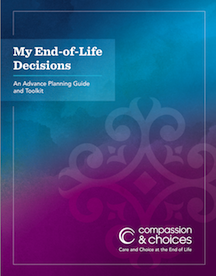 Compassion & Choices offers several different types of addenda that you can review for possible addition to your Advance Directive. Anytime you add an addendum you need to sign, date and have it (them) witnessed at the same time you sign and witness your Advance Directive so that the dates match. Always physically attach any addendum to your Advance Directive.
Compassion & Choices offers several different types of addenda that you can review for possible addition to your Advance Directive. Anytime you add an addendum you need to sign, date and have it (them) witnessed at the same time you sign and witness your Advance Directive so that the dates match. Always physically attach any addendum to your Advance Directive.
Learn More
Learn About Organ Donation
Most Advance Directives ask if you wish to donate your organs or body at the time of your death. You are never too old to have parts of your body give life and function to someone in dire need. LEARN MORE HERE about the possibilities on the Organ Donation section of this website.
Learn About Funeral, Mortuary and Burial Options
Most Advance Directives will ask if you have made a choice about the disposition of your body after death. There is a growing consciousness about the toxicity of some of our current practices. LEARN MORE HERE about different choices on this section of the website.
Signing & Witnessing Your Advance Directive
If you want you Advance Directive and any Addendum to be legally recognized as documents that represent your specific wishes for your end of life care, you MUST sign and date them in front of a Notary Public OR in most states, in front of two witnesses that meet specific conditions. You will find these conditions stated on the signature pages of your Advance Directive. These are common sense requirements such as: the person must be over 18 years old, must not be a beneficiary of your estate, must not be your doctor or medical Agent etc. A few states require that you have a Notary Public AND two witnesses sign your Advance Directive.
Advance Care Planning Organizer
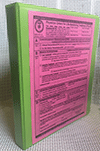 Click on the following bar to download a free PDF free document describing one way to organize your Advance Care Planning Documents so that they are easy to find and easy to keep up to date. Although the content is protected by copyright, you may print and share copies with friends and family as long as no one charges for the document(s).
Click on the following bar to download a free PDF free document describing one way to organize your Advance Care Planning Documents so that they are easy to find and easy to keep up to date. Although the content is protected by copyright, you may print and share copies with friends and family as long as no one charges for the document(s).
Additional Resources for Advance Care Planning
The Center for Practical Bioethics
The Center for Practical Bioethics is a nonprofit, free-standing and independent organization nationally recognized for its work in practical bioethics. For more than 30 years, the Center has helped patients and their families, healthcare professionals, policymakers and corporate leaders grapple with difficult issues in healthcare and research involving patients. The Center does not wait to be called upon. Learn More
Institute for Human Caring at Providence St. Joseph Health
The originators of the concept of Whole-Person Care, the institute offers many helpful resources for both patients and providers .
The Coalition for Compassionate Care of California
CCCC is an interdisciplinary partnership of leaders from health care systems, organizations, government agencies, consumer organizations, and the general public. Through advocacy, education, and resource development, CCCC works to ensure organizations and communities have the information, resources, and tools to expand palliative care across the continuum of care.
Learn more
Institute for Healthcare Improvement
IHI is a leading innovator in health and health care improvement worldwide. For more than 25 years, IHI has brought together experts, leaders, faculty, and caregivers at all levels of life and word to find solutions to widespread health care problems that seem intractable. Learn more
American Bar Association
A Toolkit for Advance Care Planning
American Bar Association
Ten individual guides “tools” to various topics relating to end of life care planning such as Conversation Scripts: Getting Past Resistance – of family members who don’t want to discuss end of life concerns. Download from their website. FREE
Learn More
Harvard Health
 Advance Care Planning Guide
Advance Care Planning Guide
Harvard Medical School – Harvard Health Publishing
A comprehensive guide to understanding advance care planning. Order online for ebook download or printed and mailed copy. $18 – $26.
Learn More
National Healthcare Decisions Day
An organization whose mission it si to inspire, educate and empower the public and providers about the importance of Advance Care Planning. They hold an annual National Heathcare Decisions Day each year on April 16th, the day after tax day..”the only thing certain is death and taxes.” Learn more
